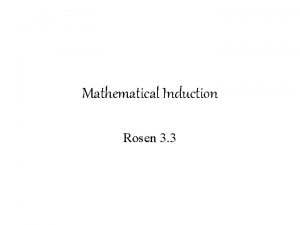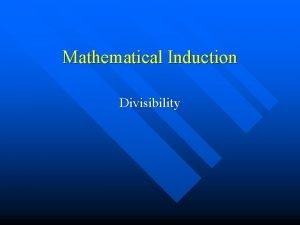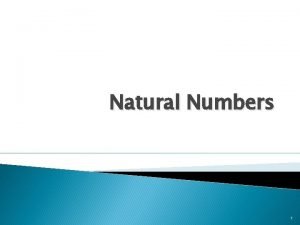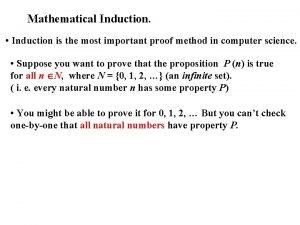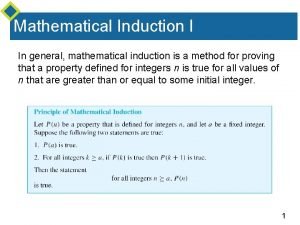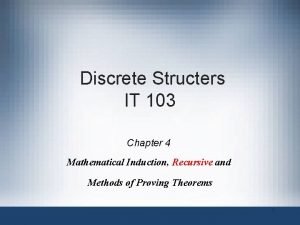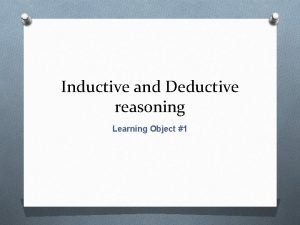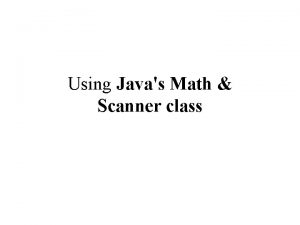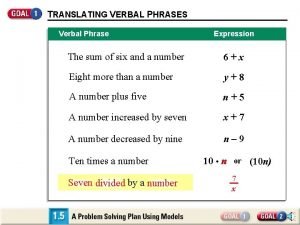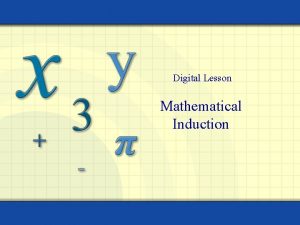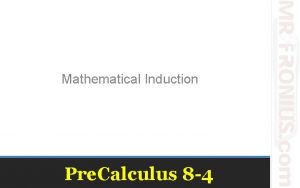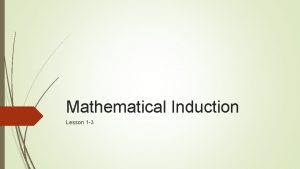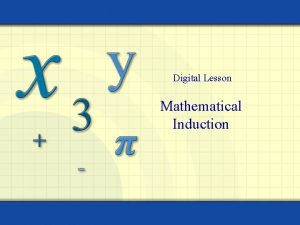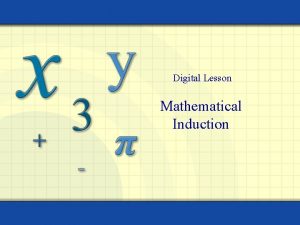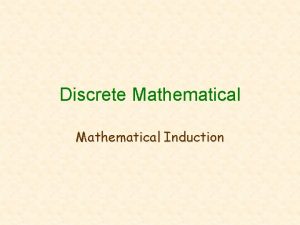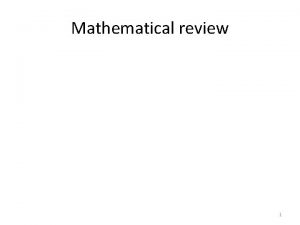Mathematical Induction 1 What is induction A method
















- Slides: 16

Mathematical Induction 1

What is induction? A method of proof It does not generate answers: it only can prove them Three parts: n n Base case(s): show it is true for one element Inductive hypothesis: assume it is true for any given element Must be clearly labeled!!! n Show that if it true for the next highest element 2

Induction example Show that the sum of the first n odd integers is n 2 n n Example: If n = 5, 1+3+5+7+9 = 25 = 52 Formally, Show Base case: Show that P(1) is true 3

Induction example, continued Inductive hypothesis: assume true for k n Thus, we assume that P(k) is true, or that n Note: we don’t yet know if this is true or not! Inductive step: show true for k+1 n We want to show that: 4

Induction example, continued Recall the inductive hypothesis: Proof of inductive step: 5

What did we show Base case: P(1) If P(k) was true, then P(k+1) is true n i. e. , P(k) → P(k+1) We know it’s true for P(1) Because of P(k) → P(k+1), if it’s true for P(1), then it’s true for P(2) Because of P(k) → P(k+1), if it’s true for P(2), then it’s true for P(3) Because of P(k) → P(k+1), if it’s true for P(3), then it’s true for P(4) Because of P(k) → P(k+1), if it’s true for P(4), then it’s true for P(5) And onwards to infinity Thus, it is true for all possible values of n In other words, we showed that: 6

The idea behind inductive proofs Show the base case Show the inductive hypothesis Manipulate the inductive step so that you can substitute in part of the inductive hypothesis Show the inductive step 7

Second induction example n n Show the sum of the first n positive even integers is n 2 + n Rephrased: The three parts: n n n Base case Inductive hypothesis Inductive step 8

Second induction example, continued Base case: Show P(1): Inductive hypothesis: Assume Inductive step: Show 9

Second induction example, continued Recall hypothesis: our inductive 10

Notes on proofs by induction We manipulate the k+1 case to make part of it look like the k case We then replace that part with the other side of the k case 11

Third induction example Rosen, question 7: Show Base case: n = 1 Inductive hypothesis: assume 12

Strong induction Weak mathematical induction assumes P(k) is true, and uses that (and only that!) to show P(k+1) is true Strong mathematical induction assumes P(1), P(2), …, P(k) are all true, and uses that to show that P(k+1) is true. 13

Strong induction example 1 Show that any number > 1 can be written as the product of primes Base case: P(2) n 2 is the product of 2 (remember that 1 is not prime!) Inductive hypothesis: P(1), P(2), P(3), …, P(k) are all true Inductive step: Show that P(k+1) is true 14

Strong induction example 1 Inductive step: Show that P(k+1) is true There are two cases: n k+1 is prime It can then be written as the product of k+1 n k+1 is composite It can be written as the product of two composites, a and b, where 2 ≤ a ≤ b < k+1 By the inductive hypothesis, both P(a) and P(b) are true 15

16
 Mathematical vs non mathematical economics
Mathematical vs non mathematical economics Strong mathematical induction
Strong mathematical induction Mathematical induction
Mathematical induction Mathematical induction divisibility
Mathematical induction divisibility Mathematical induction ppt
Mathematical induction ppt Mathematical induction
Mathematical induction Natural numbers definition with example
Natural numbers definition with example Mathematical induction
Mathematical induction Induction proofs
Induction proofs Geometric sequence closed form
Geometric sequence closed form Principle of mathematical induction
Principle of mathematical induction אינדוקציה מתמטית
אינדוקציה מתמטית Symposium advantages
Symposium advantages What is inductive research
What is inductive research Mathematical formulas editor on blackboard
Mathematical formulas editor on blackboard Mathematical functions in java
Mathematical functions in java How to write a verbal model
How to write a verbal model

